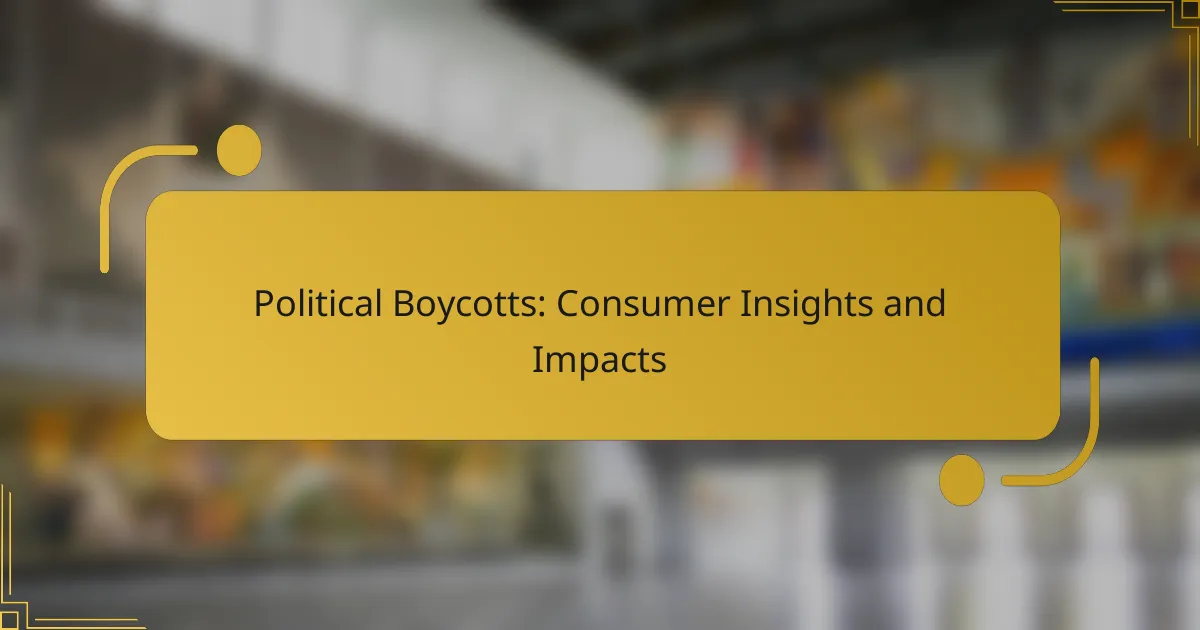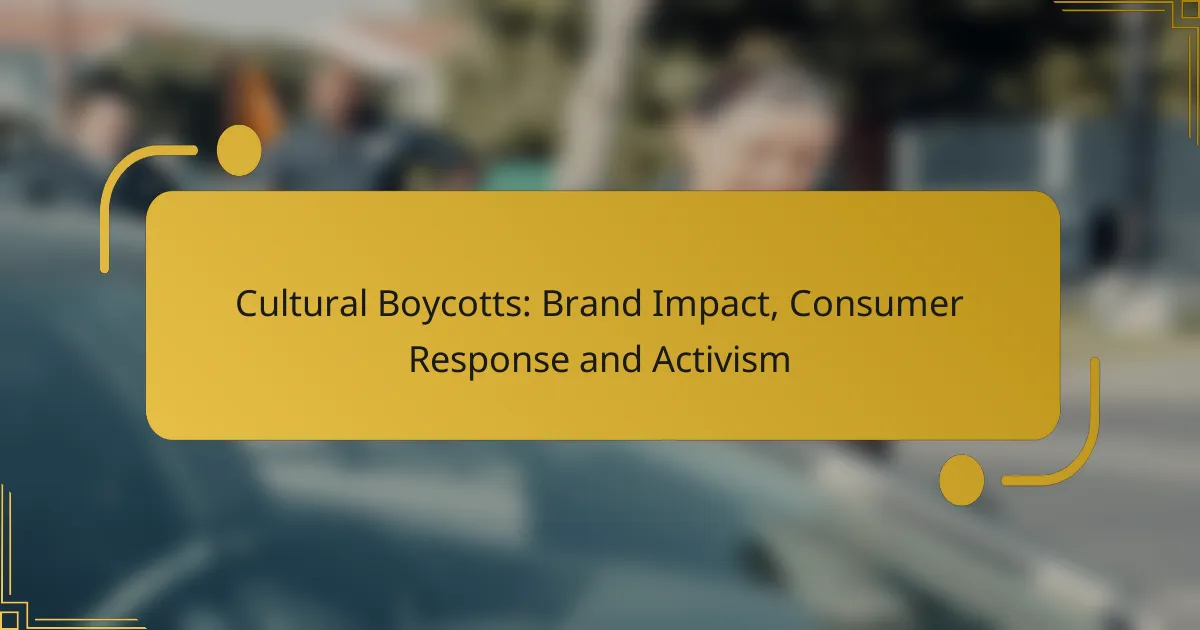Successful boycotts have emerged as a powerful tool in modern activism, showcasing the impact of collective consumer action on corporate behavior and social issues. By leveraging grassroots mobilization, social media, and coalition building, these movements not only raise awareness but also drive significant changes in policies and practices. Notable examples, such as protests against Starbucks, Chick-fil-A, and H&M, illustrate the effectiveness of targeted campaigns in advocating for social justice and accountability.
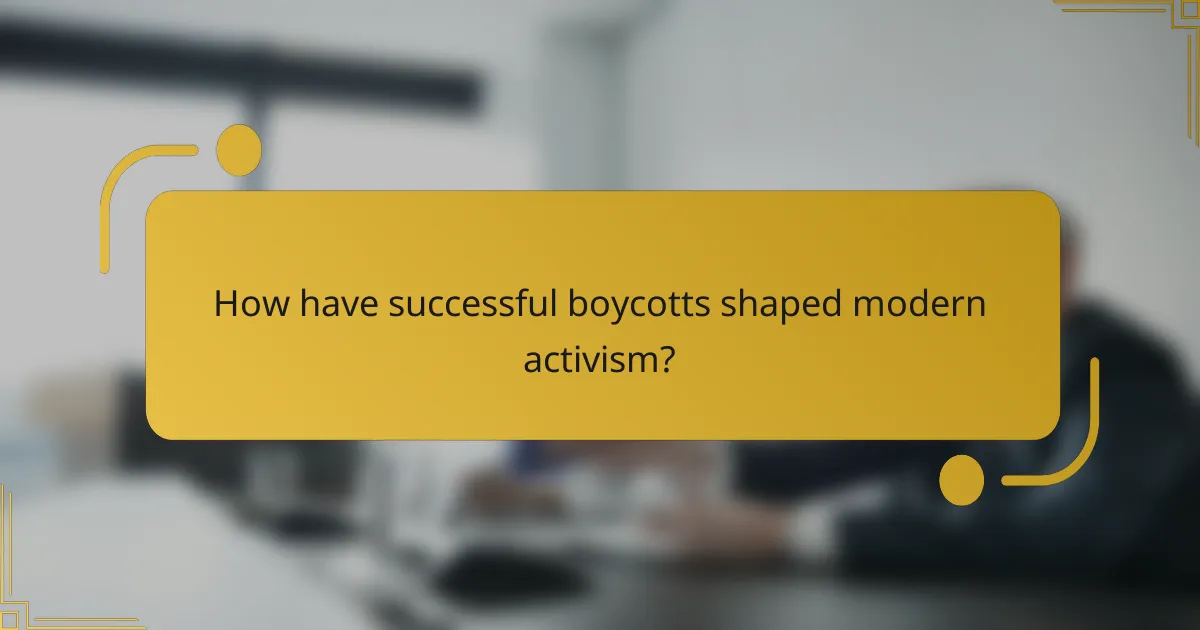
How have successful boycotts shaped modern activism?
Successful boycotts have significantly influenced modern activism by demonstrating the power of collective consumer action. They mobilize communities, raise awareness about social issues, and often lead to tangible changes in corporate policies and practices.
Impact of the Montgomery Bus Boycott
The Montgomery Bus Boycott, initiated in 1955, was a pivotal moment in the American civil rights movement. By refusing to use public buses, African Americans in Montgomery, Alabama, effectively challenged racial segregation and highlighted systemic injustice.
This boycott lasted over a year and resulted in a Supreme Court ruling that declared segregation on public buses unconstitutional. It showcased the effectiveness of sustained, organized resistance and inspired future movements across the globe.
Lessons from the Nestlé boycott
The Nestlé boycott, which began in the 1970s, focused on the company’s aggressive marketing of infant formula in developing countries. Activists highlighted the health risks associated with formula feeding in areas lacking clean water, leading to widespread public outcry.
This boycott taught activists the importance of transparency and ethical practices in corporate behavior. It also emphasized the need for clear messaging and the power of grassroots mobilization in influencing corporate policies.
Influence of the Anti-Apartheid Movement
The Anti-Apartheid Movement, particularly in the 1980s, utilized boycotts as a strategic tool against the South African government’s racial segregation policies. Global boycotts of South African goods and divestment from companies operating in the country played a crucial role in raising awareness and applying economic pressure.
This movement illustrated how international solidarity and coordinated actions can lead to significant political change. It also highlighted the effectiveness of combining boycotts with other forms of activism, such as protests and advocacy campaigns, to achieve a common goal.
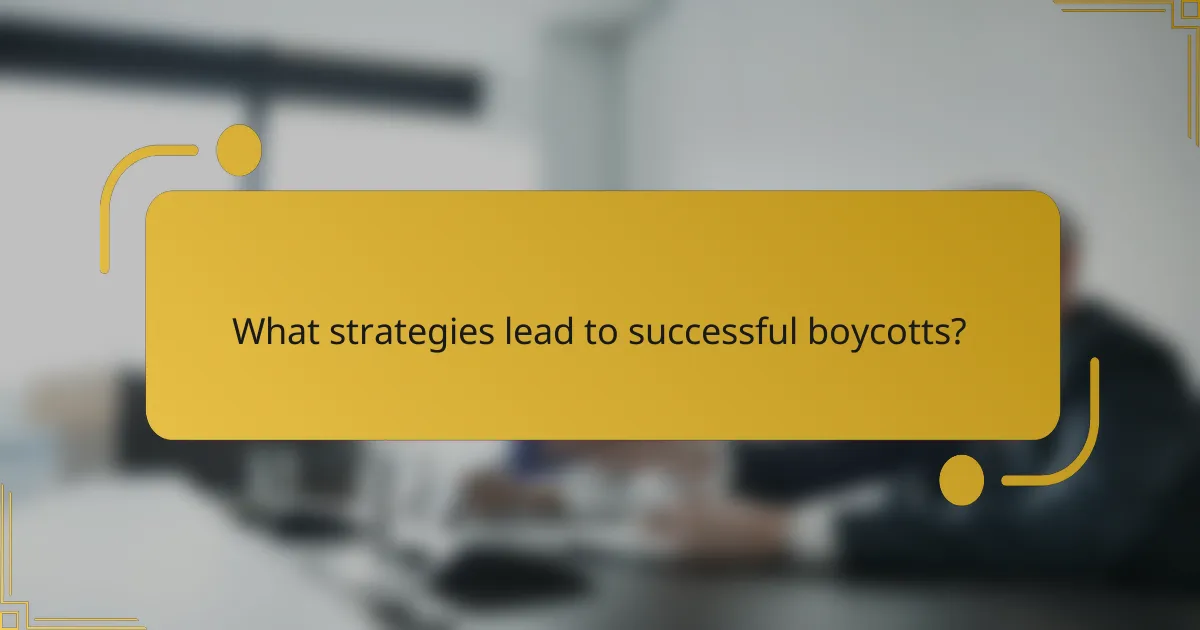
What strategies lead to successful boycotts?
Successful boycotts often rely on a combination of grassroots mobilization, effective social media use, and coalition building among organizations. These strategies help to amplify the message, increase participation, and create a unified front against the targeted entity.
Grassroots mobilization techniques
Grassroots mobilization involves engaging local communities to participate in a boycott. This can include organizing rallies, distributing flyers, and hosting informational meetings to raise awareness about the cause. Personal connections and local leaders can significantly enhance participation.
Effective grassroots strategies often utilize door-to-door canvassing or community events to foster a sense of ownership among participants. Ensuring that the messaging resonates with the community’s values is crucial for sustained engagement.
Effective use of social media
Social media serves as a powerful tool for spreading awareness and rallying support for boycotts. Platforms like Twitter, Facebook, and Instagram allow organizers to reach a wide audience quickly and efficiently. Creating shareable content, such as infographics or videos, can help convey the boycott’s message compellingly.
Utilizing hashtags can also unify the conversation and make it easier for supporters to find and share information. Regular updates and engagement with followers keep the momentum going and encourage more people to join the cause.
Coalition building among organizations
Building coalitions with other organizations can significantly enhance the impact of a boycott. By partnering with groups that share similar goals, activists can pool resources, share expertise, and reach a broader audience. This collaboration can also lend credibility to the boycott.
Effective coalition building requires clear communication and shared objectives. Regular meetings and joint campaigns can help maintain alignment and strengthen the collective effort. It’s essential to ensure that all partners are on the same page regarding messaging and strategies to avoid confusion and dilution of the cause.

What are notable case studies of successful boycotts?
Successful boycotts often arise from social movements aiming to influence corporate behavior or policy changes. Notable examples include protests against companies like Starbucks, Chick-fil-A, and H&M, each highlighting different social issues and demonstrating the power of collective consumer action.
Starbucks and racial bias protests
In 2018, Starbucks faced backlash after two Black men were arrested at a Philadelphia location for sitting without making a purchase. This incident sparked widespread protests and calls for a boycott, leading the company to implement racial bias training for its employees. The boycott highlighted the importance of corporate accountability in addressing systemic racism.
As a result of the protests, Starbucks not only changed its training protocols but also publicly committed to improving diversity and inclusion within its workforce. This case illustrates how consumer activism can prompt significant corporate policy changes.
Chick-fil-A and [censured] rights
Chick-fil-A has been at the center of controversy due to its financial support for organizations opposing [censured] rights. In response, various activist groups and consumers initiated boycotts, particularly during Pride Month. These actions aimed to pressure the company to reconsider its donations and public stance on [censured] issues.
The ongoing boycotts have led to mixed results, with some consumers continuing to support the brand while others remain steadfast in their opposition. This case demonstrates the complexities of boycotts, where consumer loyalty can be deeply divided based on social values.
H&M’s environmental sustainability boycott
H&M has faced criticism for its fast fashion model, which is often linked to environmental degradation. Activists have called for boycotts to raise awareness about the negative impacts of clothing production on the planet. In response, H&M has launched initiatives aimed at sustainability, including recycling programs and commitments to using more eco-friendly materials.
The effectiveness of the boycott has prompted H&M to make substantial changes, reflecting a growing consumer demand for sustainable practices in the fashion industry. This case highlights how environmental concerns can drive consumer behavior and influence corporate strategies.

What criteria determine the success of a boycott?
The success of a boycott is primarily determined by its ability to influence public opinion, drive consumer behavior, and prompt corporate policy changes. Key factors include the level of public awareness, consumer participation, and the responsiveness of the targeted company.
Public awareness and media coverage
Public awareness is crucial for a boycott’s success, as it generates the necessary attention to mobilize support. Effective media coverage can amplify the message, reaching a broader audience and increasing pressure on the targeted entity.
Utilizing social media platforms can enhance visibility and engagement, allowing grassroots movements to spread rapidly. Campaigns that secure coverage in mainstream media often see higher participation rates and greater impact.
Consumer participation levels
High levels of consumer participation are essential for a boycott to exert pressure on companies. The more individuals who actively choose to abstain from purchasing a product or service, the more significant the financial impact on the business.
Organizers should aim to create clear calls to action and provide easy ways for consumers to participate, such as petitions or social media campaigns. Engaging influencers can also help mobilize larger groups and sustain momentum.
Corporate response and policy changes
The ultimate measure of a boycott’s success is the response from the targeted corporation. If a company acknowledges the boycott and makes meaningful policy changes, it indicates that the campaign has effectively influenced its decision-making.
Monitoring corporate responses can provide insights into the effectiveness of the boycott. Successful campaigns often lead to commitments to change, such as improved labor practices or environmental policies, demonstrating the power of collective consumer action.

How do boycotts affect businesses financially?
Boycotts can significantly impact businesses financially by reducing sales, damaging brand reputation, and increasing operational costs. When consumers collectively refuse to purchase a company’s products or services, the resulting decline in revenue can lead to long-term financial challenges.
Case study of Nike’s Colin Kaepernick campaign
Nike’s partnership with Colin Kaepernick, who became a controversial figure for his protests against racial injustice, sparked a nationwide boycott. Initially, some consumers pledged to stop buying Nike products, leading to a temporary dip in stock prices.
However, the campaign ultimately resonated with a large segment of the population, particularly younger consumers, resulting in a surge in sales. Nike reported a significant increase in revenue, demonstrating that aligning with social movements can enhance brand loyalty and market share when executed thoughtfully.
Financial impact on Gillette after #MeToo ad
Gillette’s advertisement addressing toxic masculinity in the context of the #MeToo movement faced backlash from some consumers who felt alienated by the message. This reaction led to a notable drop in sales shortly after the ad’s release, highlighting the risks associated with taking a strong stance on social issues.
Despite the initial financial setback, Gillette’s parent company, Procter & Gamble, emphasized the importance of long-term brand positioning over short-term profits. The campaign sparked conversations about masculinity and responsibility, which could lead to a more engaged customer base in the future, although the immediate financial impact was negative.
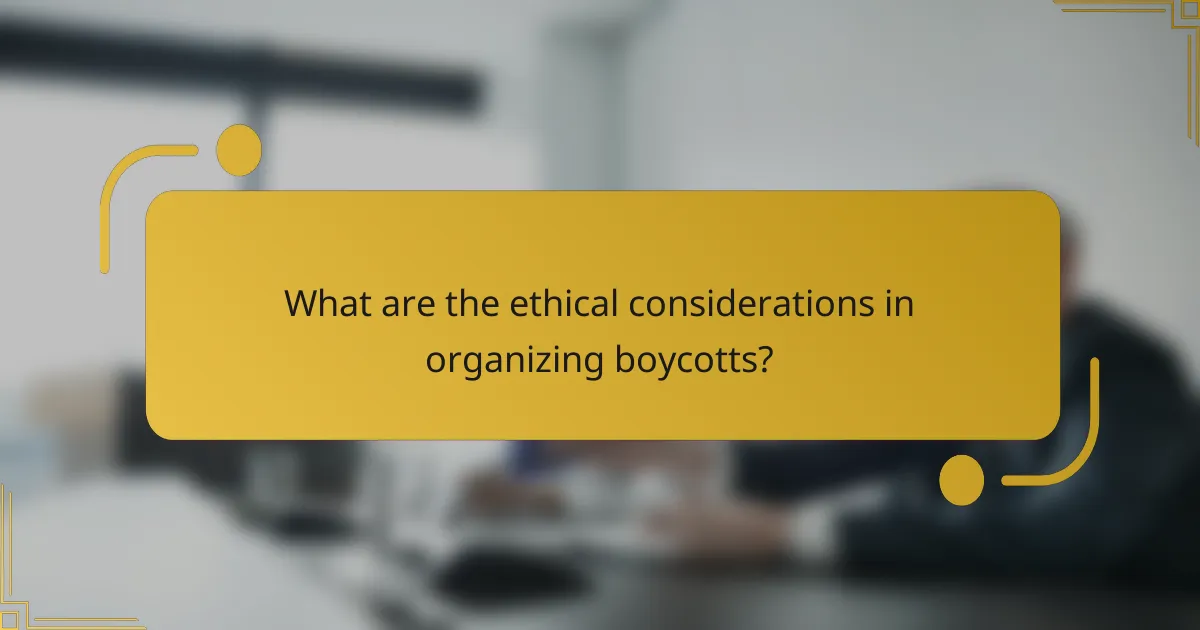
What are the ethical considerations in organizing boycotts?
Organizing boycotts involves several ethical considerations, including the impact on consumers, businesses, and communities. It is crucial to weigh the potential benefits of social change against the economic consequences for those involved.
Balancing consumer rights and corporate ethics
Consumers have the right to express their dissatisfaction with a company’s practices through boycotts. However, this action must be balanced with the ethical implications for employees and stakeholders who may suffer from reduced sales. Understanding the broader impact of a boycott can help ensure that it promotes positive change without causing undue harm.
For example, a boycott targeting a corporation for unethical labor practices may lead to job losses for workers who are not involved in decision-making. Therefore, it is essential to consider alternative actions, such as advocacy or dialogue, that might achieve similar goals without negative repercussions.
Long-term impacts on communities
The long-term effects of boycotts can significantly influence local communities, both positively and negatively. Successful boycotts can lead to improved corporate practices and greater accountability, fostering a culture of ethical business. However, they can also result in economic downturns in areas reliant on the targeted company.
Communities should assess the potential for lasting change against the risk of economic instability. Engaging with local leaders and stakeholders can provide insights into how a boycott might affect the community’s overall well-being, ensuring that the action taken aligns with the community’s values and needs.


